

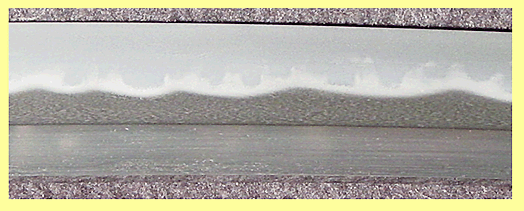


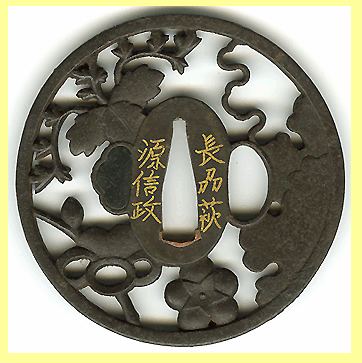
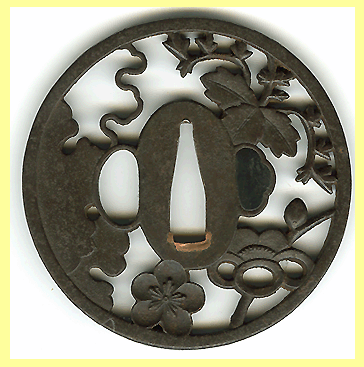

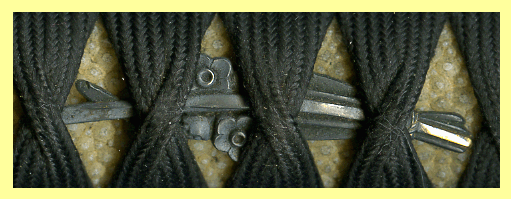
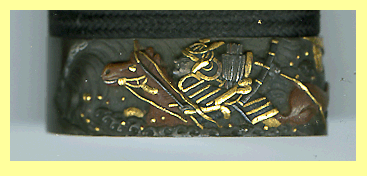
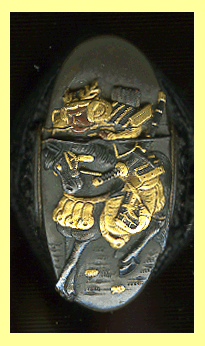
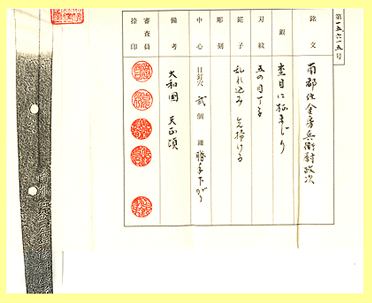
FINELY MOUNTED KOTO KATANA BY MASATSUGU
This is a wonderful Koto katana by the second generation Kanabo Masatsugu. The cutting edge of this sword is 26 1/8 inches. Below is some information about this smith and the Kanabo school of sword making:
The latter part of the Muromachi Era was a time of constant warfare. Prior to this time, the large Buddhist temples of the Nara and Kyoto areas controlled much of the military strength. The Yamato Tegai School was one of the major sword producers of the Kamakura Era. They received their name because they prospered in front of the Tegai gate of the Todai-ji Temple in Nara. Due to the repeated conflicts of this Muromachi Era, the power of these temples weakened and the smiths lost their patronage causing their schools to fall into decline. The Kanabo School came into being during these declining times. The Tegai smiths, Shinya Masanaga and Fujiwara Masanaga are thought to have founded the Kanabo School when they moved their center of sword production to the Kanabo area of Nara. We find the name, Kanabo, appearing in their signatures as early as 1555. This gives us a good idea of the time frame for the establishment of this school.
Kanabo swords, particularly katana, were highly prized by Samurai of the Sengoku Era of constant warfare. This is because of their superior strength and cutting ability. This helps to explain the existence of so many Kanabo blades today when compared with other swords that were produced in great numbers during this period of constant warfare. Simply put, they worked. They were made for combat and proved their capabilities.
There are three generations of smiths from this school who used the name, Masatsugu. The first generation is thought to have produced swords around the Tenbun Era (1532-1555). There are very few extant works by the first generation and his signature is very close to that of the second generation. The second generation, however, has left a large number of works of various types. The earliest dated work appears to be the third year of Genki (1573). The latest is the twentieth year of Tensho (1592). The third generation worked around the Keicho Era (1596-1615). Few extant works exist and no dated works have been found.
SUGATA: The blades tend to be wide and thick and this is a prime example. The kissaki is long and wide.
JITETSU: In general the kitae has a flowing feeling and is a mixture of itame and mokume. Also masame can be found in areas. The ji-nie tends to be uneven. The overall hada pattern will be prominent and somewhat coarse.
HAMON: The yakihaba is wide. It consists of o-notare mixed with gunome-choji-midare. The gunome hamon will usually has a mixing in of box shapes in which the base of the box is wider than the top so that the shoulders slant inward. The interior of the ha is highly active with ko-ashi and yo. The overall appearance of the gunome-choji hamon will be similar to the Bizen School.
BOSHI: Maru with a long kaeri. It is almost ichimai in appearance.
MEI: Nanto Ju Kanabo Hyoenojo Masatsugu Saku
KOSHIRAE: This blade comes with an excellent Edo period koshirae. The tsuba is iron and of the Choshu school. It has a gold attribution to Choshu Nobumasa who worked around 1750. The fuchi and kashira are of the Soten school and depict warriors in battle. Tyhe munuki are shakudo and are of a floral nature. The saya is lacquered in multi colors with abalone shell mixed in. Very nice.
PRICE: $na